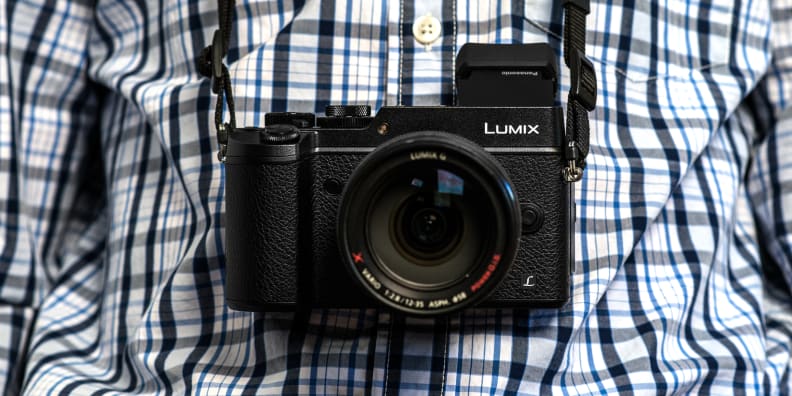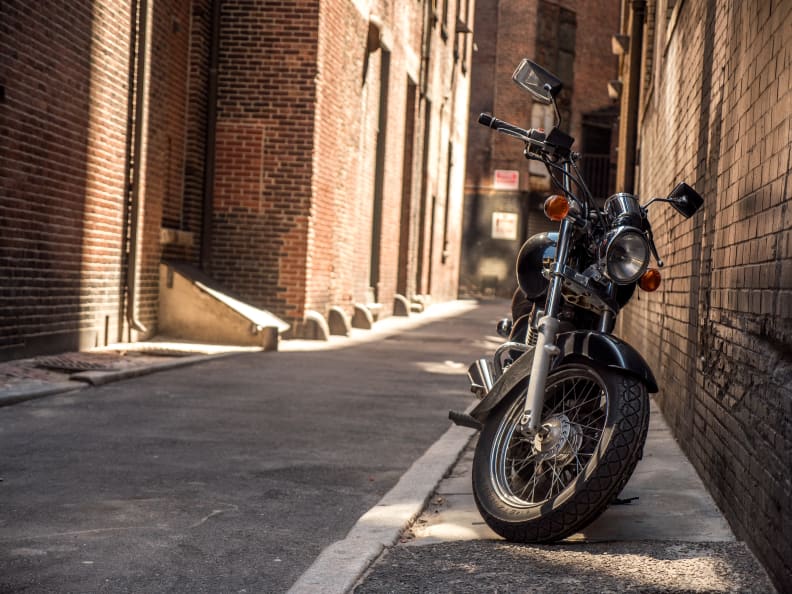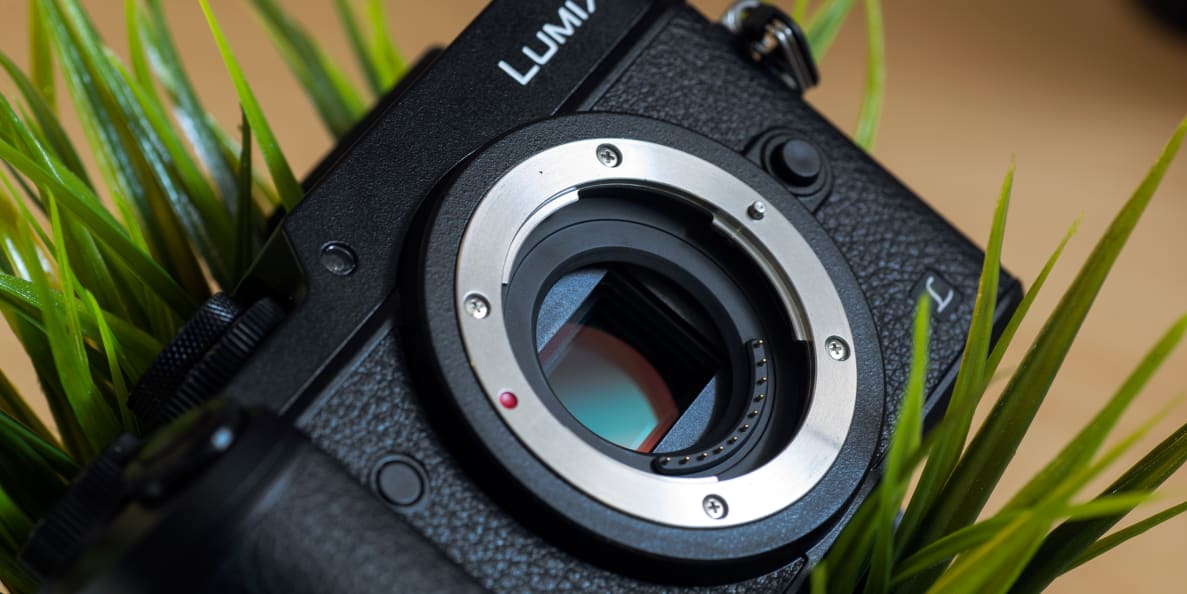Pros
Cons
The GX7 was a great camera with a wonderful rangefinder-inspired design and some cutting edge features that was completely overshadowed by the new class of top-tier mirrorless cameras. As good as the GX7 was, it was a victim of its time. Now its successor, the Panasonic Lumix GX8 (MSRP $1,199.99 body-only) is here to earn the GX series the respect that it deserves.
But while the idea of a pro-quality mirrorless camera is no longer in doubt, the value of a $1,200 (body-only) mid-range one still is. Sitting at a price point barely below cameras like the GH4 and on par with entry-level full-frame DSLRs like the Nikon D610 and Canon 6D, the GX8 has a lot to overcome.
After spending more than a week shooting with Panasonic's new baby, however, we're confident it'll do just fine. With 4K video, an upgraded 5-axis image stabilization system, a more streamlined design, and the highest resolution Micro Four Thirds sensor to date, the GX8 isn't getting overshadowed by anyone.
Design & Handling
It looks like the GX7 hit the gym
When you first take the GX8 out of the box, there's a certain familiarity to the camera's brick-like body. Halfway between an SLR and a rangefinder, the GX8 is a shade smaller than my old Zenit 122 with a brawnier build that feels very much like a smaller GH4.
{{amazon name="Panasonic LUMIX DMC-GX8SBODY DSLM Mirrorless 4K Camera Body Only, Dual Image Stabilization (Silver)", asin="B011B8QX32", align="left"}}
It still features the hallmark of a rangefinder design though, squeezing a tilting EVF in the top-left corner. It is much taller than the GX7, with a squared off grip that has deeper recesses for your fingers to latch onto. It completes the look with a faux leather coating and matte black, die-cast magnesium alloy frame. Compared to the curvy GX7, this is a more straightforward, grown-up camera—like trading your favorite hoodie for a freshly pressed suit.
The grip is slanted on top, providing enough room for Panasonic to include a control wheel and shutter release. The top of the camera is home to a re-imagined set of controls, including two control wheels, two programmable function buttons, a power lever, and a mode dial sitting atop an exposure compensation wheel. A hot shoe lives in between the EVF and the mode dial, and a fleshed-out focus mode selector is located right below.
{{ photo_gallery "tour" }}
All these controls make it very easy for advanced photographers to dial in the perfect settings, but the GX8 will be a little overwhelming to first-time users. Still, shooting with the GX8 is relatively simple thanks to the inclusion of several automatic modes and controls, not unlike your typical point-and-shoot. There's still a bit of a learning curve, but this is a good camera for aspiring photographers.
The GX8 is also flexible when it comes to lining up your shot. You can use either the articulating 3-inch, 1.04m-dot LCD or the 2.36m-dot tilting electronic viewfinder for framing. Both of these options are great for different reasons: the LCD is perfect for shooting at odd angles and for videographers, while the EVF is your best option for shooting in bright light. I personally wound up using the EVF almost exclusively, though it's great to have options.

The more things change, the more they stay the same.
In my time with the GX8, I found the controls to be quite rewarding. I'm especially fond of the ability to use the rear touchscreen as a focus selector while framing with the EVF. It's very simple to use—you just drag your finger on the screen while you look through the EVF—but it's powerful, letting you quickly adapt to your subject without having to actually take your eye off the shot.
It's not all roses, however. While the extra control dials are useful—especially the exposure compensation dial—the rest of the buttons are extremely low profile, making them sometimes difficult to hit. It's a small complaint, but it's one we don't have with most of the other cameras in this class.
{{ photo_gallery "design" }}
Features
More horsepower means more fun features
Taking a peek inside, the GX8 is built around a new 20.3-megapixel Four Thirds sensor with no anti-aliasing filter. It's backed up by a new quad-core Venus Engine processor that enables many of the camera's more cutting-edge features. That's a seriously potent combo that is only enhanced by Panasonic's new implementation of image stabilization.
In the past, Panasonic opted to put its optical image stabilization in its lenses, meaning any Panasonic Micro Four Thirds camera would need Panasonic lenses in order to enjoy IS. When the GX7 hit the scene, it brought in-body image stabilization that worked even when using lenses—like these from Olympus—without image stabilization. On the GX8, it's even better: while the camera offers in-body image stabilization, it can work in concert with OIS-enabled Panasonic lenses, for a total of five stops of stabilization (per Panasonic).
If you haven't used a Micro Four Thirds camera in some time, it might shock you to see how powerful and responsive they've become. Not only can the GX8 take 7+ JPEGs per second, but the buffer for shooting RAW+JPEG will let you take about 30 shots at the fastest (non-reduced res) speed before petering out in about three seconds and change. While that's not even close to something like the Nikon 1 J5, it's easily ahead of many DSLRs.

A compact mirrorless powerhouse makes the added burden of weight a faint memory.
On top of that, the boosted processing power allows you to shoot in 4K at 30 or 24 frames per second—though you may need to get a faster SD card. If you're shooting a particularly tricky subject, the GX8 comes equipped with the 4K photo features found on Panasonic's G7 and GH4. This lets you take 4K-sized (8MP) stills at up to 30fps, picking out the exact frame that you want after the fact.
The viewfinder is extremely rewarding to use, as it puts a ton of information front and center, right in the miniature display. Unlike an optical viewfinder, the EVF can display just about anything you'd normally find on the rear LCD—meaning things like zebra stripe over-exposure warnings, focus peaking, manual focus assist windows and more can be easily used on the fly.

Articulating screens are a godsend for videographers.
Like most modern cameras, the GX8 comes loaded with connectivity options like onboard WiFi and NFC pairing. With Panasonic's Image App, you can port pictures from your camera to your smartphone, or even use your mobile as a remote complete with live view. The camera will also lean on the smartphone for GPS data, and there are a few more options you can mess around with baked in. The GX8 does struggle to connect when the battery is low, so be sure to juice your cells as often as possible if you're using WiFi.
Performance
Color us impressed
Considering the GX8 is sold body-only with no kit option, it's abundantly clear that Panasonic views this camera as an enthusiast-first body. As we noted in our first impressions of it, this is a camera designed to compel existing Micro Four Thirds shooters to upgrade. Given that this model comes without a lens, we paired the GX8 with a few common lenses—like the X Vario 12-35 f/2.8 to see what it could do.
For starters, the camera is sharp as a tack when paired with the right glass, thanks to the new, high-res sensor. Though by default it applies a decent amount of software oversharpening to JPEGS, you can easily tone it down (or ramp it up) in-camera by using the bottom function button. If you do that, you'll also be able to use fine controls for saturation, noise reduction, and contrast.

EXIF: 35mm, ISO 200, 1/400, f/2.8
The GX8 renders colors very accurately in most situations, provided you have the correct white balance. If you're in daylight or mostly-sunlit scenes, you can just leave your white balance setting in auto and you'll be fine in this regard. Occasionally you'll notice a slight orange tinge to shots taken in incandescent light, and a slight green hue to those taken under fluorescent light, but a custom white balance or shooting in RAW will fix that.
One of the concerns with the new 20-megapixel sensor is increased noise. We found that wasn't much of a concern, though, as the GX8 held onto dynamic range surprisingly well. After opening up the extended ISO range, you'll be able to move base ISO to 100 instead of 200, and with that we recorded up to 12.7 stops of dynamic range. This results in a fantastic level of detail in shadows and highlights, even if you get a little playful with contrast.

Noise reduction is effective at higher ISO settings, but edge fidelity suffers a bit.
Where smaller sensor cameras typically fall a little flat at about ISO 3200, the GX8 also does well through ISO 6400 or so. In fact, its performance in this regard is eerily similar to that of the GH4. Combine that with the improved base ISO image quality (and the increased resolution) and it's clear that Micro Four Thirds sensors have taken another step forward.
Video performance is also quite impressive, though like the Panasonic G7, the GX8 offers 4K video only at 100Mbps, with 8-bit export over HDMI to an external recorder. That leaves it slightly behind the GH4 and the new GH4R, which can output 4:2:2 10-bit video via HDMI.

City scenes are difficult to get right, but shooting in RAW helps.
If all those numbers just went over your head, don't worry. Video in HD or UHD are similarly sharp, though you'll need a decently wide aperture and a fairly well-lit scene to get the best results. Clips are sharp, smooth, and relatively free of artifacts—perfect for everything up to commercial work.
{{ photo_gallery "sample-photo" }}
Conclusion
Panasonic has a winner on its hands
As good as the GX8, it's hard to overlook its $1,200 body-only price tag. That kind of price invites some serious competition, including entry-level full-frame DSLRs from Canon and Nikon and a slightly aging class of flagship mirrorless options. But the GX8 puts together an enviable collection of still and video features in a compact package powered by the best Four Thirds sensor we've seen to date.
In all our time with the GX8, none of our camera staff had anything truly negative to say about it—and we're professional critics. It's a rock-solid, complete camera with no notable flaws. It's fast, accurate, sharp, shoots great video, has loads of customization and manual controls, and it's compact enough to travel anywhere when paired with the right lens.

Tilting viewfinders are a great feature for shooting in bright light.
Perhaps the biggest knock against the GX8 is that it isn't highly specialized. If your primary focus is shooting video, the Panasonic GH4 (with the YAGH unit) or Sony A7S is a better option. If your focus is on certain stills—where the look of a full-frame camera is more desirable—go for the Sony A7R II, or the Nikon D610. And if you shoot sports or often find yourself in inclement weather, something like the Canon 7D Mark II or Samsung NX1 is probably more appropriate. But every single one of those cameras is more expensive than the GX8, and require stronger forearms to lug around—they're not only heavier, but use bigger lenses as well.
For a generalist who has feet equally in the realm of stills and video, or someone who just wants a damn fine camera that can do it all, the GX8 hits all the right notes. You'll need to shell out close to $2,000 to equip it with the kind of glass that'll push it to its potential, but it's worth it.
If $1,200 is just too rich for your blood then there are a few options. If you can live without the tilting EVF and some of the more advanced features, the Panasonic G7 isn't far off from the GX8 and costs quite a bit less. If you couldn't care less about video, the Olympus OM-D E-M5 mark II and OM-D E-M10 mark II provide similar quality at much lower price points.
If you do pick up the GX8, you'll be rewarded with a camera that is among the best examples of what a high-end mirrorless camera can be. While other cameras are bound to come along and surpass it, for the time being the GX8 is a standout member of an increasingly impressive collection of Micro Four Thirds bodies. The GX7 may have been a wallflower, but the GX8 is easily among the best in the class.
By the Numbers
All said and done, the Panasonic GX8 is a top dog in its category. Delivering seriously sharp shots, good color accuracy, and excellent video performance, this is a great all-around camera. There really isn't an area of weakness on the GX8.
Color and White Balance
Color performance is merely "good" with the GX8, but that benchmark is edging ever so closely to "functionally perfect." Posting a ∆C 00 (saturation corrected) error of 2.46, and an overall saturation of 100.1%, color accuracy is almost as good as it gets in consumer-level cameras. You're not going to notice errors outside of blues getting a little saturation bump.
White balance is surprisingly average for a Panasonic camera, though the results are still decent. If you were to leave your white balance setting at "auto," you can expect shots in incandescent light to have a slight orange tinge (~1450k error), fluorescent light a slight greenish hue (~1000k error), and daylight to be basically perfect (<50k error).

No dealbreakers here.
Keep in mind, many of these errors can be either sidestepped or fixed by shooting RAW instead of JPEG-only, but it's still good to know that the camera is capable of processing decent stills in a web-ready format.
Sharpness
When it comes to sharpness, this camera's sensor can keep pace with the best of them. The GX8 comes body-only, so there's no kit lens to use for testing. Consequently, we used a handful of lenses to give the GX8 a workout in the labs. Even when using the venerable Olympus 14-42 f/3.5-5.6 kit lens, the GX8 was able to max out our scoring pretty handily.
I will say that the camera uses a fair bit of software oversharpening by default to get there, and it was never more evident than when we paired the camera with a Sigma 60mm f/2.8 ART. It was almost comical to see the huge spike in oversharpening, but I should point out you can turn this down in the advanced controls menu by hitting the rear Fn button. If you're not a fan of small-but-intense haloing in your JPEGs, this is a setting you'll be messing with quite often.
Obviously, whatever lens you use will determine the performance ceiling of your camera. While there are plenty of decent pieces of glass out there, We can't say that you'll never have problems with chromatic aberration, edge sharpness, etc.
Dynamic Range
If you're worried about dynamic range on the GX8: don't be. While the GX7 struggled a little bit here, the GX8 is able to maintain more high-quality dynamic range at more ISO settings.
Specifically, the GX8 can manage 8.49 stops of high-quality DR at ISO 100, while that number doesn't hit 0 until ISO 12800. For a Micro Four Thirds camera, that's very good—usually we see sensors peter out at ISO 6400. This will allow you to bump contrast, and nudge exposure without losing too much detail when you edit your shots.
Obviously, this isn't going to quite touch the performance of pro DSLRs like the Nikon D4s that boasts 9+ stops of high-quality DR at base ISO, but it's decent enough to warrant discussion.
Video
Obviously, the ability to shoot 4K video is no small draw to a camera, but I should point out that it's still not quite at the level of the Panasonic GH4. For example, the GX8 can't do 10-bit 4K recording, nor can it do high-framerates or use its HDMI port to export a higher-bitrate signal.
Oh well.
Video clips taken at 4K boast a measured line-pairs per picture height of 1250-1300 in bright light, and "only" 900-1000 in low light (60 lux). Motion performance is very good, though I will say that you can get better results with regards to artifacting and trailing by changing capture settings to 1080/60p.
Low light is a bit of an issue, but not a dealbreaker. In order to maintain a 50 IRE image, you'll need ambient lighting of 13 lux or higher. While that in and of itself isn't so bad, it's not that great in comparison to some other cameras at a similar price point. This isn't the camera you want for low-light video.
Meet the tester
A seasoned writer and professional photographer, Chris reviews cameras, headphones, smartphones, laptops, and lenses. Educated in Political Science and Linguistics, Chris can often be found building a robot army, snowboarding, or getting ink.
Checking our work.
Our team is here to help you buy the best stuff and love what you own. Our writers, editors, and experts obsess over the products we cover to make sure you're confident and satisfied. Have a different opinion about something we recommend? Email us and we'll compare notes.
Shoot us an email


